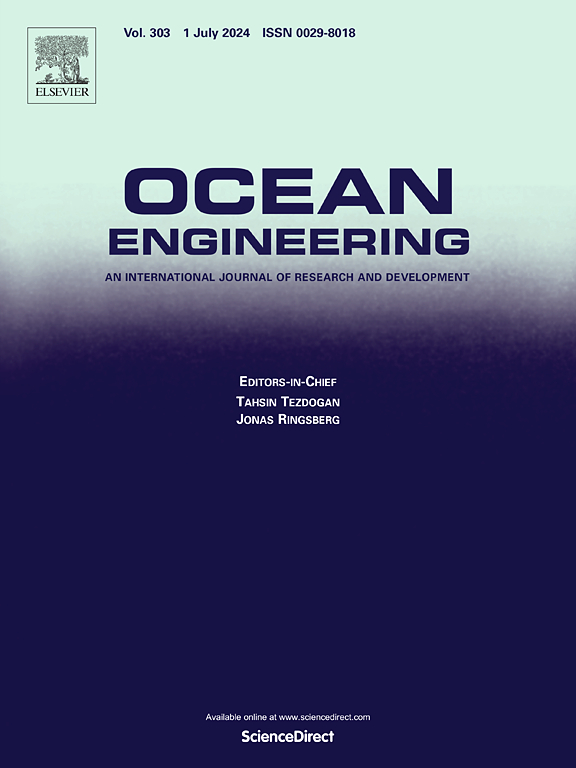集成柔性包层和声子晶体的新型机翼水下滑翔机的减振降噪研究
IF 4.6
2区 工程技术
Q1 ENGINEERING, CIVIL
引用次数: 0
摘要
随着水下滑翔机所携带传感器精度的提高,环境噪声的干扰问题越来越受到人们的关注。通常,水下滑翔机的机翼在受到流体载荷时会产生很大的水动力噪声。为了减少振动和噪音,本研究设计了一种结合柔性包层和声子晶体(pnc)的新型机翼。柔性包层允许对机翼周围的流场进行调制控制。研究了边界速度分布,得到了流动分离的位置和机翼对分离的阻力。包层特性被优化,以减少由机翼产生的流动噪音。pnc通过优化晶格常数、孔隙率和凹槽距离来实现机翼的振动控制,从而降低了流动激发的噪音。在流体动力噪声仿真中,新型机翼在0 ~ 200 Hz范围内平均降噪3.5 dB,在21 Hz范围内最大降噪20.2 dB。此外,柔性包层翼在111 ~ 168 Hz范围内的噪声增加也得到了很大的改善。最后,利用海螺-4000型水下滑翔机进行了水箱实验,验证了水动力噪声仿真的准确性,验证了新型机翼设计对减振降噪的效果。本文章由计算机程序翻译,如有差异,请以英文原文为准。
Vibration and noise reduction of underwater gliders with a novel wing integrating flexible cladding and phononic crystals
As the accuracy of sensors carried by underwater gliders increases, the interference from ambient noise has drawn increasing attention. Typically, the wings of underwater gliders can produce great hydrodynamic noise when subjected to fluid loads. To reduce vibration and noise, this study designs a novel wing that combines flexible cladding and phononic crystals (PnCs). The flexible cladding allows for modulation control of the flow field surrounding the wing. The boundary velocity profile is explored to obtain the position of flow separation and the wing's resistance to the separation. The cladding characteristics are optimised to reduce the flow noise generated by the wing. The PnCs achieve vibration control of the wing with optimised lattice constant, porosity, and groove distance, reducing the flow-excited noise. In the hydrodynamic noise simulation, the novel wing reduces the noise by an average of 3.5 dB within 0–200 Hz and obtains a maximum noise reduction of 20.2 dB at 21 Hz. In addition, the noise increase of the flexible cladding wing within 111–168 Hz is greatly improved. Finally, a tank experiment was conducted using a Petrel-4000 underwater glider to confirm the accuracy of hydrodynamic noise simulation, proving the effect of the novel wing design for vibration and noise reduction.
求助全文
通过发布文献求助,成功后即可免费获取论文全文。
去求助
来源期刊

Ocean Engineering
工程技术-工程:大洋
CiteScore
7.30
自引率
34.00%
发文量
2379
审稿时长
8.1 months
期刊介绍:
Ocean Engineering provides a medium for the publication of original research and development work in the field of ocean engineering. Ocean Engineering seeks papers in the following topics.
 求助内容:
求助内容: 应助结果提醒方式:
应助结果提醒方式:


